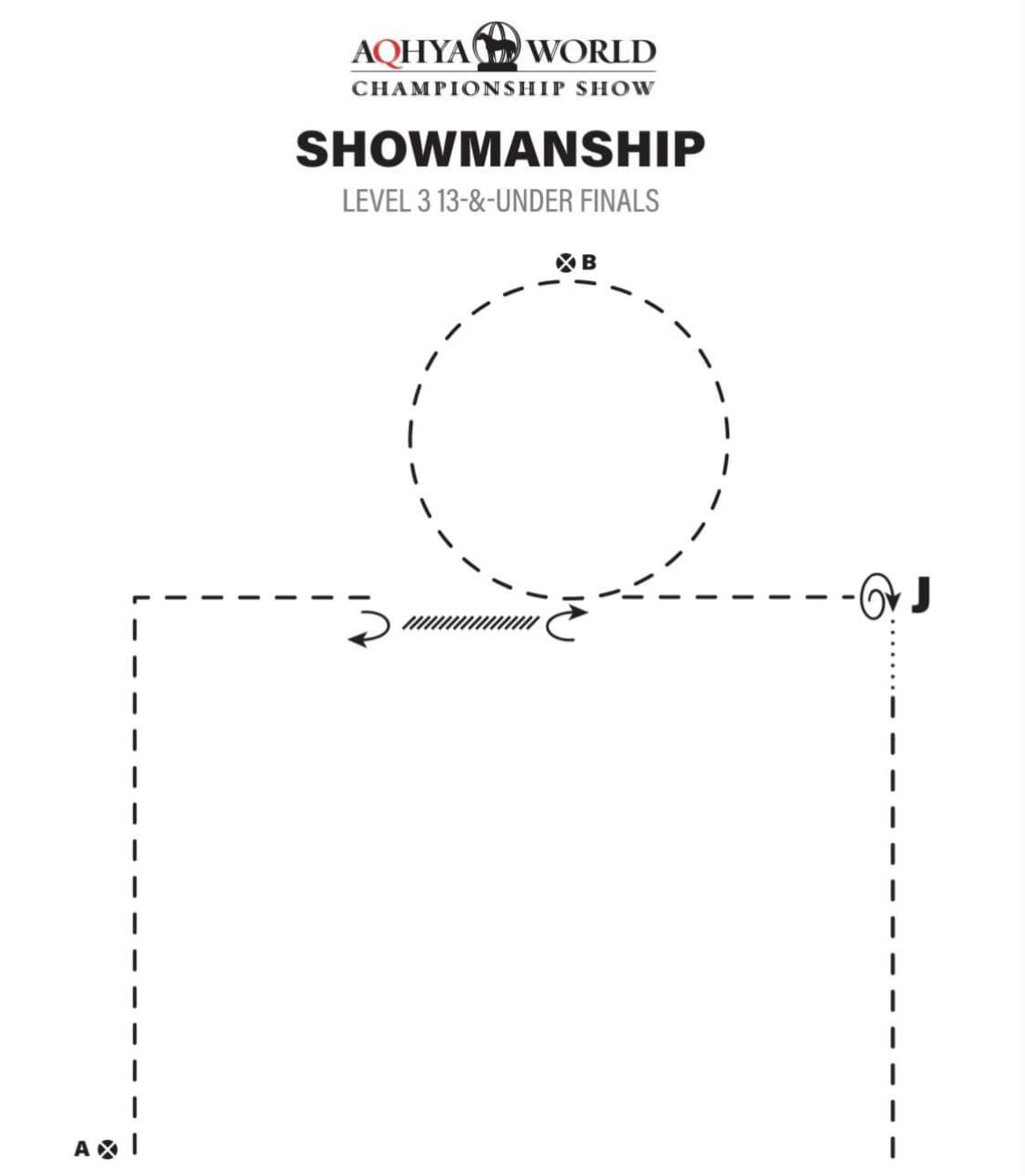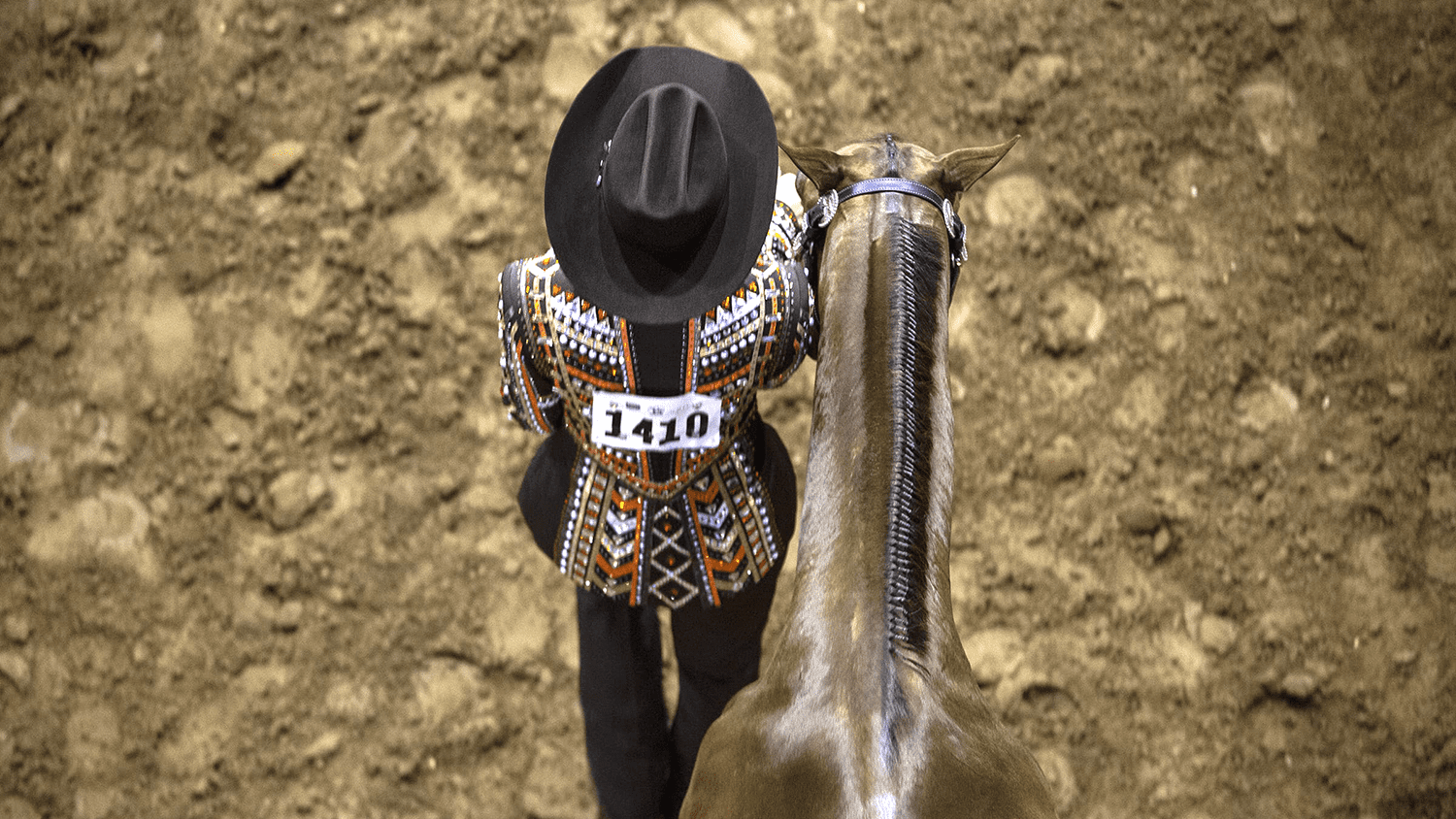 GoHorseShow would like to thank AQHA Judge Daren Wright of Chillicothe, Ohio for taking the time to break down the Level 3 – 13&U Showmanship pattern for us.
GoHorseShow would like to thank AQHA Judge Daren Wright of Chillicothe, Ohio for taking the time to break down the Level 3 – 13&U Showmanship pattern for us.
There will not be a preliminary pattern for this class, and it will only be run once. You may view the pattern displayed below or download it here.
We chose this pattern as it is certainly one of the more challenging at the show. However, those not showing in this class can still benefit as there are many elements from it in the patterns of other classes at the Youth World.
When approaching any showmanship pattern, the exhibitor not only needs to think about how they are going to lay out the pattern, but also think about how the judge will analyze it from a judge’s perspective. Knowing how the judge will evaluate each maneuver can ultimately influence your score. I firmly believe every exhibitor should read the rule book and educate themselves as much as possible on the scoring system and the fundamentals of the class.
When reviewing this showmanship pattern, we notice that not every maneuver is done at a marker. That means the exhibitor is going to have to be very aware of their position in the arena and the position of the judge to end up in the right spot for the presentation.
Before the class, the judges typically meet as a group to discuss the elements, any “hot spots” which are areas where mistakes may happen, and the general flow and scoring of the class. Each maneuver will be scored individually, so it is important to focus on all aspects of your pattern.
 This pattern starts at Cone A. When the judges look up and see the exhibitor at Cone A, that is their first impression of your run and scoring starts immediately. So, it’s essential to have your horse set up, alert, and well groomed, and the exhibitor is poised, confident, and ready. You only have one chance to make a great first impression. This first impression is a very integral part of your pattern.
This pattern starts at Cone A. When the judges look up and see the exhibitor at Cone A, that is their first impression of your run and scoring starts immediately. So, it’s essential to have your horse set up, alert, and well groomed, and the exhibitor is poised, confident, and ready. You only have one chance to make a great first impression. This first impression is a very integral part of your pattern.
1. The first maneuver of this pattern is a trot up arena to center, square corner right. The judges will be looking for an exhibitor who efficiently and confidentially moves right into the trot in unison with their horse. The trot line and square corner should be straight and purposeful giving the judges a great impression of their first maneuver.
2. The next maneuver is to stop and perform a 180-degree (1/2) turn. This is a vital element of the pattern. How well your horse stops is critical because it shows the horse’s responsiveness. The horse should stop hard and crisp and not dribble down to a stop. Once the horse is stopped, the exhibitor will get in position to complete their turn. The turn should be crisp and smooth. The horse’s spine should be straight from hip to head, all while staying on the pivot foot. The right hind leg should remain straight up and down while executing the turn, and this will enable the horse to stay balanced on that leg and not step forward or backward. It is important to finish and close the turn, but not allow your horse to over or under turn.
3. The next maneuver is back 6-8 steps. Once the horse has completed their turn, the exhibitor will get in position to back. It is very crucial to stay beside your horse and not in front of it to back. Being in front of your horse for the back will incur a “severe” penalty. The backup in this pattern can be tricky. It is essential to start and stop in unison, showing teamwork and accuracy. Some exhibitors add quite a bit of speed in their backup, but it will be important to not have so much backward momentum that you cannot stop your horse in the correct area of the pattern. Speed is great, but accuracy must come first. There is no marker to indicate where to stop, so the exhibitor will need to be very aware of their distance.
4. Next is another 180-degree turn. Again, the exhibitor must complete a smooth, crisp turn, all while maintaining that right hind pivot foot.
5. The next maneuver is to trot a circle within Cone B, continue trotting to the judge, and stop. The exhibitor should progress swiftly into the trot, staying in unison with their horse. Since the horse is on the outside of this arc, it will need to have a big step and be very aware of the exhibitor’s body position to keep that smooth, harmonious trot. Again, the horse should stop hard and crisp and not dribble down to a stop.
6. The setup will be scored individually. More and more, we see exhibitors not putting a lot of thought or accuracy into the setup. Getting your horse to set up is “Showmanship 101.” A quick and correct setup will always be beneficial to your score.
7. The inspection should be crisp, but natural. The exhibitor should be poised and sure of their timing when moving around their horse. It is acceptable to check your horse, making sure it stays square, is not resting, etc. Exhibitors should always look pleasant and look like they are enjoying what they are doing. The exhibitor should look like a horseman and stay away from anything artificial and awkward.
8. When dismissed, the exhibitor should confidently move into their 450-degree turn. With the added length of this turn, it will be more important than ever to keep the horse’s spine straight from hip to head while maintaining a balanced leg and right hind pivot and being sure to not over or under turn.
9. To complete this pattern the exhibitor will walk 6-8 steps, trot until even with A, where the pattern will be complete, and then continue trotting to the exit. This will be the exhibitor’s last chance to impress the judges, so it is very important to finish strong. The walk and trot should both be mindful, purposeful, and attacked with authority. Each maneuver is as essential as the other, and it is imperative that you show from the first step to the last stage of the pattern.
Overall, the judges are looking for a team effort, communication between horse and exhibitor, and someone who can challenge and attack the pattern. The exhibitor and horse should be confident and synchronized, showing style and accuracy. Have fun and sell this pattern to the judges.
Even if you make a small mistake, never let them see you sweat. What might be a minor hiccup to you in your pattern, may not even be noticed by the judges, so it is essential to keep your game face on.
Judges want to see you do well, want to see you win, and are your biggest cheerleaders. Within your performance and demeanor, let the judges know you are there to win. Someone must win this class, so why shouldn’t it be you?









